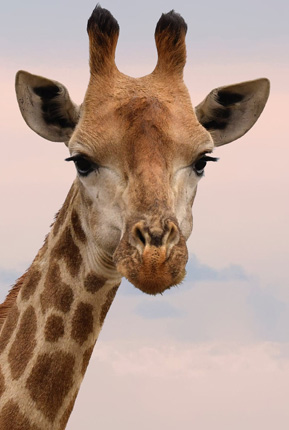
All Animals

The Giraffe: Towering Symbol of the African Savannah
The giraffe, with its towering height and distinctive appearance, is one of the most recognizable and fascinating animals of the African savannah. Known for its long neck, graceful movements, and unique coat patterns, the giraffe is an iconic species that captivates both wildlife enthusiasts and researchers alike. Native to the open woodlands and grasslands of Africa, giraffes play a crucial role in their ecosystem and face distinct challenges that impact their survival.
Giraffes are the tallest land animals on Earth, with adult males reaching heights of up to 18 feet (5.5 meters) and females up to 16 feet (5 meters). Their long necks, which can be up to 6 feet (1.8 meters) in length, are supported by a specialized arrangement of vertebrae that allows them to reach high branches and leaves, their primary food source. This unique adaptation enables giraffes to feed on vegetation that is out of reach for most other herbivores, giving them a competitive advantage in their habitat.
In addition to their impressive necks, giraffes are distinguished by their distinctive coat patterns. Each giraffe has a unique pattern of spots that vary in shape and color, ranging from light brown to reddish-brown, depending on the subspecies. These patterns provide effective camouflage in the dappled light of their natural environment, helping them blend in with the trees and grasses.
Giraffes are social animals that live in loose, fluid groups known as towers. Unlike many other herd animals, giraffe groups do not have a strict hierarchy or stable membership. Instead, individuals come together and separate frequently, forming temporary associations that vary in size and composition. These groups often consist of females and their young, while males may form smaller, bachelor herds or remain solitary.
The diet of a giraffe primarily consists of leaves, twigs, and fruits from acacia trees and other vegetation. Giraffes use their long, prehensile tongues, which can be up to 18 inches (45 centimeters) long, to grasp and strip leaves from branches. This feeding behavior not only provides them with the nutrients they need but also helps shape the vegetation in their habitat, influencing the growth patterns of trees and shrubs.
Despite their towering presence and adaptability, giraffes face several challenges in the wild. Habitat loss due to agricultural expansion and human encroachment, along with poaching and climate change, have negatively impacted giraffe populations. Some subspecies, such as the Rothschild’s giraffe, are particularly endangered and require targeted conservation efforts to ensure their survival.
Conservation organizations and wildlife reserves are working to address these threats through habitat protection, anti-poaching measures, and research initiatives. Efforts are also being made to raise awareness about the giraffe's plight and to promote sustainable practices that support the health of their ecosystems.
In many cultures, giraffes are admired for their unique appearance and gentle nature. They are featured in folklore, art, and educational programs, highlighting the importance of preserving these remarkable animals and their habitats. Their towering presence in the savannah serves as a reminder of the diversity and wonder of the natural world.
In summary, the giraffe, with its majestic height and distinctively patterned coat, is a symbol of the African savannah's beauty and diversity. Its role as a browser and its social dynamics contribute to the ecological balance of its habitat. By supporting conservation efforts and fostering a deeper understanding of giraffes, we can help ensure the continued survival of this extraordinary species and the preservation of the natural world they inhabit.
